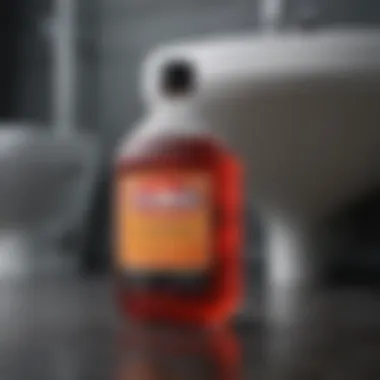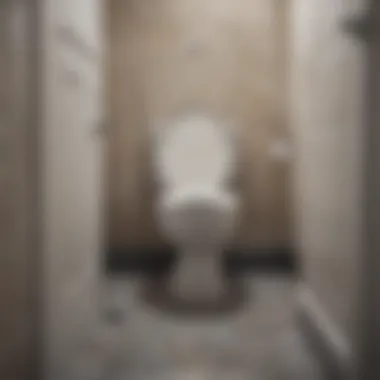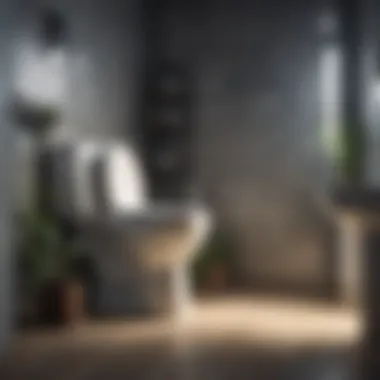Is Drano Safe for Toilets? Efficacy Evaluated


Intro
Toilet clogs are a common household annoyance. They disrupt daily routines and often require urgent attention. Drano, a household name in drain cleaning products, is frequently considered a solution. However, its efficacy specifically for toilets often raises questions among homeowners. This article aims to delve into the effectiveness and safety of using Drano on toilets, assessing its chemical properties and potential hazards. It also evaluates alternative methods for unclogging toilets and best practices for maintaining plumbing systems.
Feature Spotlight
Chemical Composition of Drano
Drano is primarily composed of sodium hydroxide, sodium nitrate, and aluminum. These ingredients work in tandem to break down organic material within clogged pipes. While effective on sinks and bathtubs, the chemical reaction generated can be harmful to toilets due to their composition. The high alkalinity and potential for generating heat might cause damage to porcelain and rubber seals, creating more problems than it solves.
Effectiveness on Toilet Clogs
Using Drano on toilets does not guarantee success. Unlike drains that have straight flows, toilets contain curves and different plumbing designs that can limit the product's reach. Furthermore, the concentrated nature of Drano could lead to insufficient breakdown of waste. Users may find themselves facing persistent clogs even after application, resulting in frustration.
"Attempting to use harsh chemical cleaners in toilets can yield unintended consequences, sometimes leading to pricier repairs and unsafe conditions."
Potential Risks
There are notable risks associated with using Drano in toilets. The chemical reaction can create heat, risking damage to the toilet itself. Moreover, if the clog is severe, the drain cleaner may not fully dissolve, leading to a hazardous mix of chemicals that could result in dangerous fumes.
- Risk of Damage: Prolonged exposure can lead to cracks in the porcelain.
- Fume Generation: Chemical reactions can produce harmful gases if mixed with other substances.
- Plumbing Impact: Regular use may corrode pipes over time, leading to more clogs.
Alternatives to Drano
Homeowners looking to avoid the risks of Drano have several safer alternatives for unclogging toilets.
- Baking Soda and Vinegar: This combination can break down minor clogs naturally.
- Plumber’s Snake: A physical tool that can effectively navigate toilet design.
- Wet/Dry Vacuum: This can aid in removing clogs without chemicals.
Adopting these methods can ensure effective cleaning without the potential hazards posed by chemical cleaners.
Best Practices for Toilet Maintenance
Ensuring proper upkeep of toilets can significantly diminish the frequency of clogs.
- Regular Cleaning: Simple cleaning methods can prevent build-up.
- Careful Flushing: Avoid flushing items that can cause blockages.
- Scheduled Inspections: Checking plumbing status can indicate potential issues before they become major problems.
By prioritizing toilet maintenance, homeowners could save time, money, and hassle from future clogs.
Foreword
In the realm of household maintenance, understanding how to effectively manage plumbing issues is of paramount importance. Particularly, when it comes to toilet clogs, the choice of product used can significantly impact both efficiency and safety. This article probes the efficacy of Drano, a well-known drain cleaner, and its application in toilets. The evaluation encompasses not just performance but also the substance and potential hazards associated with using such products in sensitive plumbing systems.
Numerous individuals encounter blockages in their toilets and often turn to Drano, trusting it to deliver fast results. However, it's critical to dissect whether this trust is warranted. The implications of using strong chemicals in toilets can be profound, affecting not only the plumbing infrastructure but also the overall safety and hygiene of the household. By exploring these elements, homeowners may make better-informed choices regarding toilet maintenance.
In this article, we will illuminate the core issues surrounding toilet clogs while examining the specifics of Drano's chemical makeup and intended use. This journey leads into a thorough investigation of potential risks when opting for Drano. Furthermore, alternatives will be presented for readers looking for safe and effective methods to tackle stubborn clogs in a less hazardous manner.
Understanding the Problem
Clogs in toilets are a common yet inconvenient issue faced by many households. Understanding the causes of these blockages is essential for determining the most effective response. Typically, issues arise due to excessive toilet paper, foreign objects, or build-up from hard water minerals. Identifying the nature and severity of the blockage is crucial.
Many may instinctively reach for chemical solutions like Drano, believing they offer immediate relief. However, the reality is that not all plumbing issues respond well to harsh treatments. Moreover, the potential for damage to porcelain, pipes, or systems can result in costly repairs. This background sets the stage for a detailed analysis of Drano’s efficacy in addressing toilet clogs.
Overview of Drano


Drano is marketed as a powerful drain cleaner, widely recognized for its ability to dissolve tough clogs. It contains active ingredients designed to break down organic matter and clear debris from pipes. Common forms of Drano include liquid gels and crystals, each promising fast action in clearing blockages.
However, the effectiveness of Drano may waver significantly depending on the nature of the clog. While it may clear some types of obstruction, using it in toilets can be problematic. Firstly, toilets are designed to process waste rather than contain chemical solutions, which can corrode essential components over time. Secondly, misuse can cause the chemical mixture to sit and accelerate damage.
Understanding these nuances assists homeowners in recognizing that while Drano can serve a purpose in some situations, its application in toilets requires caution.
Chemical Composition of Drano
Understanding the chemical composition of Drano is vital to assess its efficacy and safety for unclogging toilets. This knowledge not only helps in grasping how the product works but also its long-term implications on plumbing systems.
Active Ingredients
Drano contains several active ingredients designed to dissolve clogs, primarily sodium hydroxide and sodium nitrate. Sodium hydroxide, also known as lye, is a strong alkali that creates heat upon contact with water. This heat increase helps break down organic materials like hair and grease. Sodium nitrate acts as an oxidizing agent, further aiding the breakdown of waste matter.
In addition to these, Drano often includes aluminum shards. When these shards meet sodium hydroxide, a reaction occurs producing hydrogen gas. While this helps in unclogging, it also poses a risk; excessive gas pressure can lead to pipe damage if the clog does not release.
Some formulations also use bleach. Bleach can effectively kill bacteria, but in toilets, it may react negatively with other substances, raising concerns about safety.
pH Level and Its Implications
The pH level of Drano varies between 13 and 14, placing it in the category of strongly alkaline substances. This high pH is crucial as it indicates the product's potential to break down various clogs. However, the implications of such a high pH are significant.
A high pH solution can be corrosive to plumbing materials, particularly if used frequently. Porcelain, often found in toilet bowls, may experience damage over time. It is essential to be cautious when using Drano. Prolonged exposure to the acidic or alkaline substances can weaken pipes, leading to leaks or bursts in severe cases.
Therefore, understanding both active ingredients and pH levels is crucial when evaluating Drano for toilet clogs. Familiarity with these aspects permits homeowners to make informed decisions regarding the safety and effectiveness of their plumbing solutions.
Drano's Intended Uses
Understanding the intended uses of Drano is crucial when considering its application for unclogging toilets. Drano is designed primarily for clearing clogged drains in sinks, tubs, and shower words, with formulations targeted at breaking down organic material, soap scum, and hair. These are common blockages in these fixtures due to their construction and intended use. However, using Drano in toilets comes with specific considerations and risks.
Specific Elements and Benefits
Drano products often contain powerful chemicals like sodium hydroxide or sodium hypochlorite, which can effectively dissolve clogs. For sinks or tub usage, where the plumbing generally includes wider pipes and perhaps a greater volume of water, Drano can be more beneficial. Like the effectiveness in these fixtures, many value the quick action of the product, with some formulas offering fast results. This caters to the needs of homeowners looking for a speedy fix rather than a complete overhaul of their plumbing issues.
Yet, it is essential to remember that the toilet is unique in its design and function. Toilets have a curvature in their pipes and use water to flush waste away, which can interfere with the effectiveness of Drano. This leads us to important considerations when thinking about using it in this context, especially considering potential hazards to both the toilet and the plumbing system as a whole.
Suitable Fixtures
Drano products generally find their effectiveness in specific types of plumbing fixtures but are not ideally suited for toilets. Fixtures like sinks and bathtubs, with straightforward drainage systems, allow Drano to work effectively due to their linear pipe systems. In contrast, toilets often involve a more complex plumbing setup, including longer discharge pipes and a larger trap, which complicate the process of unclogging.
While some homeowners may resort to Drano for toilet clogs, the risks often outweigh the benefits. In addition, toilets usually require the removal of solid blockages, something that Drano is not designed to resolve effectively. This fundamental difference highlights the need for alternative approaches tailored specifically for toilet maintenance.
Common Misconceptions
Many individuals believe Drano can serve as a universal solution for all types of plumbing issues. This misconception leads to inappropriate usage in toilets, where it may not yield the desired results. Some may assume that all clogs can be treated similarly, ignoring the unique requirements of toilet plumbing. The reality is that frequent use of Drano can lead to harm rather than help.
- Drano dissolves all clogs: This is misleading. While Drano can dissolve organic substances, it often does not address tough clogs caused by non-biodegradable items, like toys or specific types of wipes.
- It can be used safely in toilets: Utilize Drano without understanding that it can cause damage to porcelain and potentially corrode plumbing systems. Drano's harsh chemicals can react adversely with the materials commonly found in toilet construction.
- Fast results are guaranteed: Homeowners expect instant results, but toilet clogs often require a more methodical solution than pouring a chemical and waiting.
Assessing the right tools and methods for each situation is paramount in effective toilet maintenance. It is essential to differentiate the common uses of Drano from its unintended consequences.
Through a careful evaluation of Drano's intended uses, potential users can better understand where and how to apply the product effectively, leading to informed decision-making in maintaining optimal plumbing conditions.
Potential Risks of Using Drano in Toilets


Understanding the potential risks associated with Drano usage in toilets is essential for homeowners. The application of chemical drain cleaners is often seen as a quick fix for stubborn clogs, but this can be misleading. Drano contains powerful substances that can potentially damage plumbing systems and pose safety risks.
Using Drano indiscriminately can lead to extensive damage that may require costly repairs. Furthermore, the toxicity of the chemicals may not only harm the plumbing but also risks exposure to individuals in the household. Thus, recognizing these potential consequences is vital.
Damage to Porcelain and Pipes
One of the primary concerns with using Drano in toilets is the potential for damage to the porcelain and pipes. Toilets are generally made from ceramic, which has a glazed surface designed to withstand routine cleaning. However, the aggressive chemical composition of Drano can compromise this surface.
- Effects on Porcelain: When Drano is applied directly, it can create micro-cracks in the glaze. Over time, these cracks accumulate mineral deposits and contaminants, ultimately leading to discoloration or potential breakage.
- Impact on Pipes: The strong caustic chemicals in Drano can erode pipes, particularly if they are made from plastic materials like PVC. Repeated exposure can cause gradual deterioration and weaken the entire plumbing system.
Given these factors, it is clear that opting for chemical solutions like Drano may not be the best course of action for maintaining toilets.
Toxicity and Safety Concerns
The toxicity associated with Drano raises substantial safety concerns for both users and household members. The chemicals in the product are not just harmful to your plumbing; they can also pose risks to human health.
- Chemical Burns and Irritations: Direct contact with Drano can lead to severe chemical burns. Even inhalation of vapors can cause respiratory issues, particularly for sensitive individuals such as children or pets.
- Environmental Impact: Once flushed, the chemicals may enter local water systems, contributing to environmental degradation. Pollutants like sodium hydroxide or bleach can disrupt aquatic ecosystems.
- Incompatibility with Other Chemicals: If Drano is mixed with other cleaning agents, it can produce hazardous gases. This not only increases the risk of accidents but also heightens health concerns for users and their families.
Utilizing safer alternatives and preventive measures can significantly mitigate these risks.
In summary, while Drano may seem effective for clearing a toilet clog, the potential damage and toxicity make it a less favorable option for homeowners. Assessing these risks can guide better decisions when dealing with plumbing issues.
Alternatives to Drano for Toilet Clogs
In considering effective strategies for unclogging toilets, understanding alternatives to Drano becomes crucial. Many homeowners rely on chemical solutions like Drano without fully grasping their implications. While these products offer quick fixes, their long-term effects on plumbing and personal safety can be concerning. Therefore, exploring other options can provide safer and more sustainable solutions for managing toilet clogs.
Utilizing alternatives not only preserves the integrity of plumbing systems but also reduces exposure to harmful chemicals. It is essential to consider both effectiveness and safety when selecting a method to address clogs. With that in mind, two prominent methods stand out: traditional plunger techniques and natural remedies.
Plunger Techniques
Plungers are among the most basic yet effective tools for unclogging toilets. Their design leverages suction, allowing users to dislodge blockages manually. The standard cup plunger, specifically designed for toilets, features a tapered rubber end that creates a seal over the drain.
When using a plunger, it is important to maintain the right posture for maximum effectiveness. Here are the steps to follow:
- Ensure the toilet has enough water: The water level should ideally be sufficient to cover the plunger.
- Position the plunger: Center it over the drain and press down gently to create a seal.
- Create suction: Push and pull the plunger in a steady rhythm, maintaining the seal.
- Check the results: After several plunges, lift the plunger to see if the water drains properly.
Using plungers also offers a cost-effective method without negative environmental impact. Thus, it becomes a widely backed choice among homeowners who prefer safe and traditional solutions.
Natural Remedies
Natural remedies provide a compelling alternative to chemical drain cleaners. These methods often utilize everyday household items and are environmentally friendly. Some popular options include baking soda, vinegar, and hot water. Here’s how they work:
- Baking Soda and Vinegar: Using both as a combination can generate carbonation, which helps break down clogs. Pour half a cup of baking soda followed by half a cup of vinegar down the drain. Allow it to fizz for about 30 minutes, then flush with hot water.
- Hot Water: Pouring hot, not boiling, water into the toilet can help dislodge minor clogs. This method is most effective when combined with either baking soda or vinegar.
- Salt: Salt can also be helpful in deterring minor blockages. Like baking soda, you can mix it with vinegar for enhanced effects.
Using these natural remedies not only avoids the risks associated with harsh chemicals but also promotes a more sustainable approach to household maintenance. It is beneficial for those who desire an eco-friendly lifestyle.
As we explore various options, remember that using non-chemical methods helps maintain healthy plumbing while avoiding harmful exposures. By prioritizing these alternatives, homeowners can ensure more effective and safe solutions for toilet clogs.
Best Practices for Toilet Maintenance
Maintaining a toilet is not just about aesthetics; it plays a crucial role in a home's overall plumbing health. Toilets withstand significant use, and proper care can prevent unwanted clogs and costly repairs. Understanding best practices for toilet maintenance helps save water, improve efficiency, and extend the lifespan of the toilet.
Preventive Measures


Preventive measures are essential to keep toilets functioning optimally. First, it is imperative to avoid flushing items not meant for toilets. This includes wipes, feminine hygiene products, and other non-biodegradable materials. Flushing these items can lead to blockages and may cause severe damage over time.
Another preventive approach involves regular inspections. Homeowners should routinely check for leaks, which often go unnoticed. A simple test is to add food coloring to the tank. If the color appears in the bowl after a while, it indicates a leak. Addressing leaks promptly can save water and mitigate further issues.
Regular usage of a toilet bowl cleaner also contributes to maintenance. These cleaners help to eliminate buildup and stains. However, it is vital to choose non-corrosive cleaners. Using harsh chemicals consistently may damage the toilet's porcelain finish and internal parts.
Effective Cleaning Techniques
When it comes to maintaining a clean toilet, effective techniques are crucial. One of the simplest methods is using baking soda and vinegar. This natural alternative helps to break down mineral deposits and eliminate odors. To use this method, pour about a cup of baking soda into the bowl, followed by a cup of vinegar. Allow this mixture to sit for at least 30 minutes before scrubbing with a toilet brush.
Moreover, it is worth noting that frequent cleaning prevents the buildup of bacteria and stains. A weekly cleaning routine, incorporating a mild cleaner, can foster a sanitary environment and enhance the toilet's appearance.
Additionally, considering the flushing mechanism's cleanliness is critical. The flush handle can harbor germs and should be wiped down regularly with disinfectant wipes. This not only improves hygiene but also encourages overall toilet care and cleanliness.
Regular inspection and basic cleaning can prevent bigger issues down the line.
By implementing these best practices, homeowners can enjoy a functional and healthy toilet without relying on chemical solutions like Drano. Careful attention to maintenance will facilitate long-term savings and a better quality of household plumbing.
When to Seek Professional Help
Knowing when to call a professional plumber can save time and prevent further damage to your toilet and plumbing system. While many homeowners might consider DIY solutions like Drano, there are scenarios when expert intervention is crucial. Understanding these situations can protect your investment and ensure the safety of your plumbing.
Signs of a Serious Blockage
A few specific indicators suggest a serious blockage that needs professional assessment. Homeowners should be aware when:
- Multiple Fixtures are Affected: If your toilet is clogging and you also notice issues in sinks or bathtubs, it could indicate a bigger blockage in the main sewer line.
- Water Backups: If water backs up into your toilet or sinks when you flush, this is a strong sign of a blockage.
- Persistent Clogs: Frequent and ongoing clogs that do not respond to plunging or over-the-counter products like Drano should raise a red flag.
- Unpleasant Odors: Bad smells coming from drains can signal severe blockages or issues with your sewage system.
Remember, ongoing problems may not just be simple clogs. They can signify more significant plumbing issues.
Recognizing these signs promptly allows for early professional intervention, potentially saving costly repairs down the line.
Cost Considerations
Understanding the costs associated with professional plumbing services helps homeowners make informed decisions. While initial expenses may seem high, neglecting plumbing problems can lead to increased damage and greater costs. Common cost factors include:
- Type of Issue: Serious blockages usually require more intense work. Clearing a simple clog can run from $100 to $300. However, finding and fixing deeper issues in the sewer line could cost significantly more.
- Location: Costs can vary greatly depending on your geographical area. Urban locations may have higher labor rates compared to rural areas.
- Accessibility: If a blockage is hard to reach, additional charges may apply for necessary tools and labor.
Ultimately, the cost of waiting to address plumbing problems can be higher than the expense of hiring a plumber. Investing in timely professional help can avoid larger damages and ultimately save money.
Ending
In concluding this article, it becomes essential to reflect on the various elements discussed regarding the use of Drano in toilets. The evaluation has not only examined the chemical properties of Drano, but it has also shed light on its potential risks and practical effectiveness when dealing with toilet clogs. Recognizing these aspects is crucial for homeowners who are often looking for quick solutions to plumbing issues.
Summarizing Key Points
To encapsulate the primary concerns raised:
- Chemical Composition: Drano contains powerful chemicals that may not be suited for toilet use, as they can harm porcelain and pipes.
- Intended Uses: While marketed for drains, Drano is often misapplied to toilets, leading to misunderstandings of its effectiveness.
- Risks Involved: Using Drano in toilets carries serious risks, from damaging plumbing fixtures to potential health hazards.
- Alternatives: There are safer methods and products for clearing toilet clogs, which can be more effective and less damaging.
- Maintenance Practices: Regular maintenance is key to preventing clogs and reducing the need for harsh chemicals like Drano.
By understanding these points, homeowners can make informed decisions regarding toilet maintenance and the products they choose to use.
Final Recommendations
Given the considerations outlined, here are some final recommendations for individuals facing issues with toilet clogs:
- Prioritize Alternatives: When possible, try natural remedies or physical methods like plunging before opting for chemical solutions.
- Regular Maintenance: Schedule regular inspections and maintenance to ensure your plumbing system is functioning properly. This can help avoid clogs before they become problematic.
- Professional Consultation: If you encounter persistent issues, it may be wise to consult a plumbing professional instead of attempting to resolve the problem with harsh chemicals.
- Educate Yourself: Understand the products you use. Reading up on their chemical composition and intended uses will help mitigate potential risks.
In essence, this evaluation of Drano and toilets illustrates the importance of cautious application of chemical products and the value of preventive practices in toilet maintenance.







